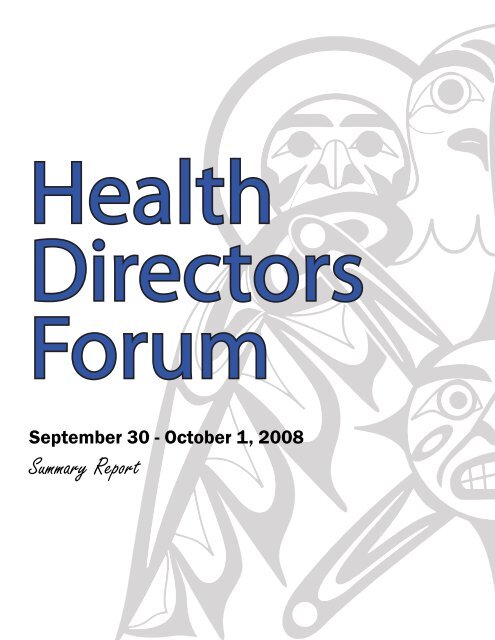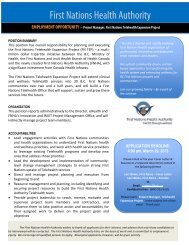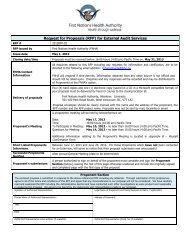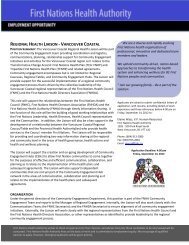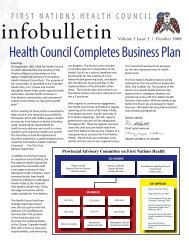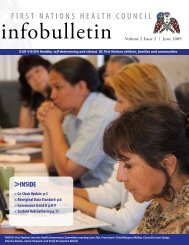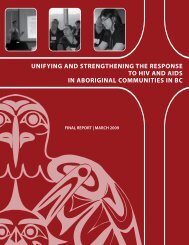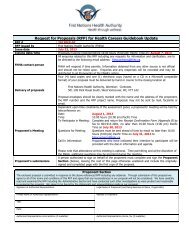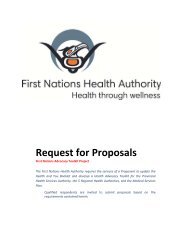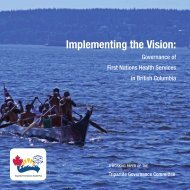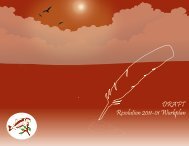pdf download - First Nations Health Council
pdf download - First Nations Health Council
pdf download - First Nations Health Council
- No tags were found...
Create successful ePaper yourself
Turn your PDF publications into a flip-book with our unique Google optimized e-Paper software.
<strong>Health</strong>DirectorsForumSeptember 30 - October 1, 2008Summary Report
Thank you to all of the <strong>First</strong> <strong>Nations</strong> <strong>Health</strong> Directorswho shared knowledge, ideas, and solutions toward theimprovement of <strong>First</strong> <strong>Nations</strong> <strong>Health</strong>. Your continuedcontributions are appreciated.
TABLE OF CONTENTSExecutive Summary Page 4FEEDBACK – <strong>Health</strong> Directors Association Page 5[A] Potential Models Page 5[B] Type of Organization Page 5[C] Membership Page 6[E] Role of Association Page 6[1] Supports for <strong>Health</strong> Directors Page 6[2} Professional Development, Training and Standardization Page 6[3] Information Sharing and Knowledge Page 7[4} Policy and Advocacy Page 7{5} Networking, Collaboration and Partnership Page 8[D] Board of Directors Page 9FEEDBACK – <strong>Health</strong> Issues Page 11a) Non-Insured <strong>Health</strong> Benefits Page 11b) Mental <strong>Health</strong> and Substance Misuse On-Reserve Page 14c) Maternal and Child <strong>Health</strong> Page 14d) Elder Care Page 18HEALTH DIRECTORS FORUM 2008 - SUMMARY REPORT 3
Executive SummaryTripartite <strong>First</strong> <strong>Nations</strong> <strong>Health</strong> Plan (Plan) calls for “an association of health directorsand other health professionals to create and implement a comprehensive capacitydevelopment plan for the management and delivery of community-based services tosupport <strong>First</strong> <strong>Nations</strong> and their mandated health organizations in training, programdevelopment and knowledge transfer”The Plan’s Governance structure for <strong>First</strong> <strong>Nations</strong> health services will have 4 pillars:1. <strong>First</strong> <strong>Nations</strong> <strong>Health</strong> <strong>Council</strong>,2. Provincial Advisory Committee on <strong>First</strong> <strong>Nations</strong> <strong>Health</strong>,3. <strong>First</strong> <strong>Nations</strong> <strong>Health</strong> Governing Body and4. Association of <strong>Health</strong> Directors.<strong>First</strong> <strong>Nations</strong> <strong>Health</strong> Directors are working to develop a common voice and at the<strong>Health</strong> Directors Forum 2007 and Interior <strong>Health</strong> Conference 2007 health directorsprovided feedback. This assisted in the framework for the 2008 <strong>Health</strong> DirectorsForum (September 30, and October 1, 2008) where the <strong>Health</strong> Directors generallyagreed for the need for a <strong>Health</strong> Directors Association and started the work on the visionfor the governing structure, mandate, principles, roles of the Association’s Boardand Membership.
E) ROLE OF ASSOCIATION:1. Supports to <strong>Health</strong> Directors• To support <strong>Health</strong> Directors dealing with “isolation”• Recruitment and retention of <strong>Health</strong> Directors• To provide a culturally appropriate and indigenous ways of doing things• Promote communities to work together and mentor other communities• Build capacity and knowledge of <strong>Health</strong> Directors, which would include personal andprofessional development opportunities2. Professional Development, Training and Standardization• Standardization of <strong>Health</strong> Directors trainingo Standard knowledgeo Accreditation processo Cultural competencieso Mentorship programso Networking with Educational institutes and <strong>First</strong> <strong>Nations</strong> organizations to provide thestandardization and trainingo Distance and online learning opportunities• Standards of excellence for <strong>Health</strong> Directors• Maintaining competencies by continued professional development and training• Code of ethics• Administrate Board policies to carry out the standardization and training goals inmandate• Mentorship opportunities• Training of people in communities• Expanding of existing skills setso Proposal writingEducational opportunities – funding, incorporate outside resourcesAffiliate with educational institutions to provide training: Athabasca <strong>Health</strong> Administration,UBC Certificate in Aboriginal <strong>Health</strong> Administration, UVIC <strong>First</strong> <strong>Nations</strong> <strong>Health</strong>Managers Training, Royal Roads, INAC Communication and Community EngagementInitiative, Red Cross etc..o Certification programs to uphold professional standards and policieso Accreditation of health centreso Availability of online and distance learning for credit (battle “isolation” factor andincrease flexibility)o Community health plan training workshopso Assist para-professional trainingo Community <strong>Health</strong> Representatives (CHRs)o Child and Youth workers
• Personal development alongside professional development:o self-careo conflict resolution and mediation skillso prevention lateral violenceo communication in businesso health information managemento budgeting and financial management training• Cultural competency training• Code of ethics for health directors and professionals• Standardized pay-grids for professionals• Manage <strong>Health</strong> Care Professionalso <strong>Health</strong>/wellness and human resources plans based on community evaluationso Job descriptions and job databaseso Longevity –keeping of staff (nurses)o Acknowledge of successful <strong>Health</strong> Directorso Better support (retreats for health workers, stress confidentiality, health days etc.)o benefits• Perform Community Needs Assessment Work Plano Professional development growth plano Budget management training/skillso Team buildingo Creation of <strong>First</strong> <strong>Nations</strong> database (nursing, social work, diabetes prevention)o Aboriginal Job Banko Create partnerships with local health service providers to share in resourceso Career planning (success plan, build leaders within)• Integrate cultural and holistic aspects to Human Resources3. Information Sharing and Knowledge• Opportunities to communicate, transfer and share resources and technologyo A common website for information, dissemination and sharingo Regional directories and gatherings managed by bands/ tribal councils themselves4. Policy and Advocacy• Collective voice for <strong>Health</strong> Directors working with <strong>First</strong> <strong>Nations</strong>• Political avenue for <strong>Health</strong> Directors to inform leadership• Working together to develop a new relationship with the Provincial and Federal Governments• Defining networking agreements and protocols for transferring and sharing information andconfidential informationo <strong>Health</strong> Directors access to health records within <strong>Health</strong> Authoritieso Integrating health teams• Promotion of <strong>Health</strong> Directors as agents of changeo Sharing of best practices to support policy development• Administrate and advocate Board policies and procedures
• Advocate for more funding (NIHB, patient travel, etc.)• Build capacity and knowledge• Build and maintain healthy <strong>First</strong> <strong>Nations</strong> communities• Advocate for betterment of health services and service providers• Tracking and sharing: create framework process for gathering information about issuesreflected to policy change• Be innovative in making policy solutions to health problemso Extended health care coverage option• Build spiritual and cultural aspects into policy change• Advocate for early notice of policy changes• Develop awareness of services and opportunities available to <strong>First</strong> <strong>Nations</strong> individualsand how to access them• Advocate for health directors and health professionals and the communities that theyrepresent through policy and at the governmental level• Encourage youth to consider health careers5. Networking, Collaboration and Partnership• Administrate Board policies to carry out the information and knowledge sharing goals inmandate• Create website to dissemination and share information; BLOG• Access to information: list of <strong>Health</strong> Directors who receive regular information• Access to information for youth• Regional gatherings• Define agreements and protocols for networking and communication between funders(<strong>Health</strong> Canada), the provincial health authorities and receivers (bands/tribal councils) &partnerships with other health organizations/ service providerso To obtain access to health directors from health authoritieso To work with health authority to allow tele-psychiatry to be delivered out of healthcentres on reserve.o To take time, distance and access to technology into accounto To recognize inequality in capacity to network (ie. The size of Northern Region)o Development of wide area patient database system Red-flag confidentiality concerns• Share knowledge – culture, traditional teachings etc with health care practitioners ineffort to seek common ground• Networks with educational institutions to provide cultural awareness and respect• Sharing of best practices• Integrate health teams
D) BOARD OF DIRECTORS:The Board of Directors will be elected from membership, and by membership.1. Criteria:• informed and knowledgeable of <strong>First</strong> <strong>Nations</strong> issues and concerns• ability to write proposals to obtain money on behalf of <strong>First</strong> <strong>Nations</strong>2. Roles:• Have advisory capacity and be able to engage with the government(s) on the <strong>Health</strong> Director’sbehalf• Long-term health plans and goals• Be accountable with a clear and transparent path of decision making• Take an advocacy approach vs. an authoritative approach• Take grassroots approach to forming Board’s advisory input – have line of communication toobtain advisory input on health issues, policies and budgets and community needs from themembership• Voice of membership from front line workers and shape the Board’s decisions.• Establish policies to carry out the mandate and goals of the Association• Use culturally relevant approach to build the organization from the outset• Establish Executive Committee/ Chief Executive Director to administrate Board policies and tohandle day-to-day operations.• Administrate Board policies to carry out purposes of Association• Develop Association’s organizational chart , which prevent political interference• Hire Association’s administrative staff• Ensure healthy working relationships• Clear boundaries and discipline manual, which would address harassment, anti-discrimination,violence in the workplace; project management; outcomes; conflict resolution and emergencysocial services.• Ensure adequate funding• Ensure adequate space and equipment• Identification of challenges and “workable solutions”
“<strong>First</strong> <strong>Nations</strong> <strong>Health</strong>Directors are the changeagents responsible forleading the way to makethings better in <strong>First</strong><strong>Nations</strong> Communities.”Grand Chief Doug Kelly[Gathering Wisdom for a Shared Journey Forum 2008]
FEEDBACK - <strong>Health</strong> IssuesThe <strong>Health</strong> Director’s feedback revealed that the Association could participate in creating and advocatingfor desired changes to the <strong>First</strong> <strong>Nations</strong> health governing system, health services and servicedelivery. The non-exhaustive list includes the following:<strong>Health</strong> IssueDesired Changes• Increase funding for NIHB – there is always a major deficit• Full coverage – patients should not receive ½ a service because of lack of coverage• Incorporate orientation of NIHB program• Include training for Staff Administering Programs• NIHB Administration:o Consider different models of delivery, which would include extended healthbenefits packages according to community’s needs• Include traditional healers and medicines in cost coverage• Give prior notice of cutbacks in NIHB fundingN o n - I n s u r e d<strong>Health</strong> Benefits(NIHB)• Consultation with <strong>First</strong> <strong>Nations</strong> on changes to NIHB policies• Increase amount of nurses, doctors, physiotherapists, dentures and dentists towork in communities or else make frequent community visits• Advocate for a patient lodge in Campbell River or North Island• Education for health providers around remoteness and isolated communities andsmall nations• Create list of providers that accept NIHB• Support special needs support services under NIHB• Incorporate a focus on prevention – dieticians, homeopathy, pathologists costscoverage – also cost of having immunizations administered by nurses brought tocommunities• Obtain copy of <strong>Health</strong> Canada’s fee schedule that providers follow to referenceand improveHEALTH DIRECTORS FORUM 2008 - SUMMARY REPORT 11
<strong>Health</strong> IssueN o n - I n s u r e d<strong>Health</strong> Benefits(NIHB)DentalDesired Changes• Dental Services:o Standardizationo Ex. Full coverage with a dentist, additional chargeso Create equal access to service/review Dental Fee Guideo Remoteness factoro Some patients are refused serviceso Set up pre-arranged up front dental funds – most <strong>First</strong> <strong>Nations</strong> patients cannot pay upfrontcostso More funding for orthodontist coverage• Dentures:o Eliminate ability of denturists to hold dentures hostage until payment made - communities arecash poor and are effectively denied accessN o n - I n s u r e d<strong>Health</strong> Benefits(NIHB)Patient Travel• Patient travelo More approvals of reimbursementso Increase mileage and meal allowances & reimbursementso Update reimbursements to reflect present and realistic travel costso Provide travel for patient’s “support people” - also provide travel for both parents when itis a child patiento Gas voucherso Higher meal allowanceso “special considerations” category for long-term patients (major surgeries)o Have submissions for reimbursements reviewed on case-by-case basiso Consider fairness of remote v. Urban travel situations – less access requires more patienttravel budgeto Meet needs of dialysis and cancer patients – require frequent and ongoing travel requirementso Meet needs of transplant surgery patients – long term visits12HEALTH DIRECTORS FORUM 2008 - SUMMARY REPORT
<strong>Health</strong> IssueN o n - I n s u r e d<strong>Health</strong> Benefits(NIHB)Prescriptions• PrescriptionsDesired Changeso Protect coverage to include supplements and daily medicationo Equal quality standards for pill prescriptions (access to the high quality brands)o Better updates to approve new pillso Better links to pharmacists to advocate on behalf of <strong>First</strong> <strong>Nations</strong> needso Process to deal with misuse of prescription drugs – over prescribing by doctors/ T3s are sold incommunitiesNIHBHearingNIHB• Hearing• Optometryo Fund <strong>First</strong> <strong>Nations</strong> to receive hearing aids, updates and replacementso Approval for eye glasses and framesOptometryo Changes to optical occur less than every 2 years... but can’t get a new prescriptions because ofNIHB policyo Renewals and replacementso Proper adequate lenso Surgery coverageo Travel costo No payments up front (community’s are cash poor and effectively denied access)HEALTH DIRECTORS FORUM 2008 - SUMMARY REPORT 13
<strong>Health</strong> IssueMental<strong>Health</strong> AndSubstanceMisuseOn-Reserve• Revamp Mental <strong>Health</strong> and Addictions:o reflect it differently in Community <strong>Health</strong> PlansDesired Changeso Guide communities through resources and opportunities available, where they are, how to access.o Build compassion for women with addictions to decrease stigmao Include harm reduction methodso Incorporate holistic/ social determinants of health approach - mental health programs should incorporateother issues: diabetes, obesity, employment etc. – getting a job IS suicide prevention yet it isnot funded by mental health dollars• Networks & Transitions:o Coordination of all departments that are involved: programs, hospitals, response workers, RCMP(drug dealing) etc.o Promote coordinated healing approach from a large team – hospitals, treatment centres, individuals,communities, Chief & <strong>Council</strong>, families etc.o Networking for services with close by <strong>First</strong> <strong>Nations</strong> communitieso Transition plans from treatment back into community& familyo Conduct community dinners around positive themes or topics so community is not just bondingaround deaths and tragedies• Tracking & Planning:o Move forward and incorporate tele-healtho Implement a “passport to health care” – tracking cards for immunization of childreno Create contact cards laminated in wallets for emergency patients in hospital (name counsellor, nurse,<strong>First</strong> Nation, health director)• IRSS – Indian Residential School Survivorso Breakdown program silos (don’t use labels such as IRSS counsellor; instead use general term ofcounsellor)o Hire people with training to work with familieso Holistic approacho Give survivors a voice in programmingo Address general impact of violence, historical trauma in the context of residential schools14HEALTH DIRECTORS FORUM 2008 - SUMMARY REPORT
Mental<strong>Health</strong> AndSubstanceMisuseOn-ReserveCont’d• Treatments & Detox:ooooIncrease medical detox centresIncrease non-medical detox centres – so that treatment patients do not return to same environmentand have addictive behaviours triggeredRemove moratorium off treatment centresReduce waiting times for treatment• NNADAP – National Native Alcohol and Drug Abuse ProgramooooooooooAddress frustrations of front-line workersMore youth treatment centres and treatment centres in generalDay treatments and aftercare, longer treatments and smaller waitlists and more proactiveapproach to referralsNeed for Follow up on discharged treatment patientsIncorporate changes in family/home environment that patients return to – ex. Physically painthouse, family counsellorsMore training programs at grassroots level – ex. Aboriginal Suicide Crisis and InterventionResponse Team (ASCIRTAdopting methods of bringing culture back into treatment – Chehalis exampleIncorporating elders into treatment and as role modelsSponsoring community events, sports, drumming and dancing activities - positive leisure programs– North American Indigenous GamesFocus on youth support and peer support – boys and girls groups, cultural and language programs,sexuality, resilience, inner strength, literacy, self-esteem and self-worth workshops• Training & Information:oooTrain qualified Mental <strong>Health</strong> Workers to reside and work in communitiesAwareness of larger impact of suicide on entire communityYouth awareness building and involvement in solutions/ connect with culture and elders• Front Line Workers:oooImplement client safety plans, self-health orientationsIdentify and work on “pieces” of mental health that are more challenging for front line workersand clientsCapacity building for front-line workers/Proposal writing and opportunities for further educationHEALTH DIRECTORS FORUM 2008 - SUMMARY REPORT 15
<strong>Health</strong> IssueDesired ChangesMaternal andChild <strong>Health</strong>• Provide a united voice to build compassion for women and children; mothers with addictions• Fatherhood Programs:o Preparation plans / what to do before baby arriveso How to support mother and selfo How to assist in child developmento Resources availableo Encouragement of fathers to attend informational and skill building programs• Research and information, opportunities available for traditional parenting methodso Overcome loss in skills due to intergenerational FAS/ Residential Schools effects etc.• Incorporate Elder Teachings – around pregnancy• Incorporate and strengthen cultural ceremonies and events around babieso Community baby welcoming feastso “Blanketing” ceremonies• Incorporate speech and language programs• Youtho Screening irono Sexual awarenesso Resource campaigns – where to accesso Female/maleo Family violence and sexual abuseo Pregnancy (Planned Pregnancy)• Screening iron, STD/HIV• Folic acid supplement, prenatal supplements (pills)• Prenatal oral health screening16HEALTH DIRECTORS FORUM 2008 - SUMMARY REPORT
• Incorporate Screening Methods:M a t e r n a land Child<strong>Health</strong>Cont’do Infant Child for screening iron, TB• Address the impact of poverty, substance abuse, remoteness on Maternal Child <strong>Health</strong>• Build community trust in health professionals• Incorporate e-tools to track baby checks, services and CDC• Incentives to do regular check-upso Coupons for moms and babies ($50/ 2 weeks for 1 year)• Use infrastructure:o Facilitate with municipality/schools/ parents to address issues in coordinated manner – assist withscreenings of childreno Sort out administration of MCH Program – should be administered under health agency rather thanchild & family serviceso Wilderness Treatment Centreo Baby Wellness Programso <strong>Health</strong> Information system – MustimuhwHEALTH DIRECTORS FORUM 2008 - SUMMARY REPORT 17
<strong>Health</strong>IssueDesired Changes• Incorporate methods and programs that work:Elder Careo Elder exercise programso Youth ambassador programso Elder lunch programso Promotion of care team dialogue about elder’s care and social interactions in thewhole community (who links who)o Elder’s Committeeo Elder Buso Aboriginal Patient and Navigatorso Gitxsan nurses example – good comfort level with elders/clients• Increase funding for and availability of methods and programs that work18HEALTH DIRECTORS FORUM 2008 - SUMMARY REPORT
AcknowledgementsIn June 2008, the <strong>Health</strong> <strong>Council</strong> put out a general call to establish a planning committee for thisforum. A committee was established representing health directors from a mix of rural, remote,transferred and integrated <strong>First</strong> <strong>Nations</strong>. The committee consisted of: Aileen Prince (Nak’azdli),Lauren Brown (Skidegate), Kim Brooks (Squamish), Laura Jameson (Little Shuswap), CarolyneNeufeld (Seabird Island), Louisa Willie (Heiltsuk), Shelley Henderson (KDC), Laurette Bloomquist(Sliammon), and Leyla Johnny (Tl’etinqox-T’in). The committee held a number of meetings over thesummer and set the direction for this forum.
FIRST NATIONS HEALTH COUNCIL#1205 - 100 PARK ROYAL SOUTHWEST VANCOUVER, BC V7T 1A2Phone: 604.913.2080Website: www.fnhc.caEmail: info@fnhc.ca


